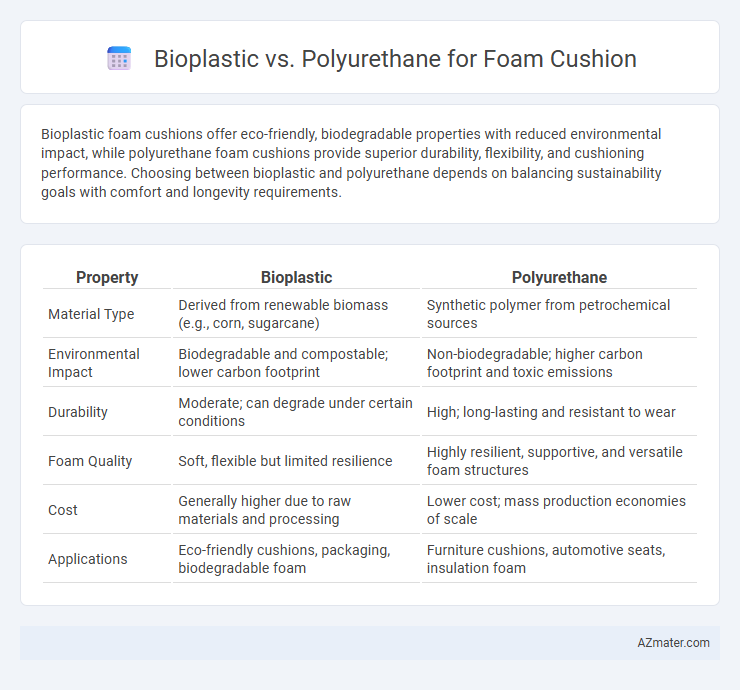Bioplastic foam cushions offer eco-friendly, biodegradable properties with reduced environmental impact, while polyurethane foam cushions provide superior durability, flexibility, and cushioning performance. Choosing between bioplastic and polyurethane depends on balancing sustainability goals with comfort and longevity requirements.
Table of Comparison
| Property | Bioplastic | Polyurethane |
|---|---|---|
| Material Type | Derived from renewable biomass (e.g., corn, sugarcane) | Synthetic polymer from petrochemical sources |
| Environmental Impact | Biodegradable and compostable; lower carbon footprint | Non-biodegradable; higher carbon footprint and toxic emissions |
| Durability | Moderate; can degrade under certain conditions | High; long-lasting and resistant to wear |
| Foam Quality | Soft, flexible but limited resilience | Highly resilient, supportive, and versatile foam structures |
| Cost | Generally higher due to raw materials and processing | Lower cost; mass production economies of scale |
| Applications | Eco-friendly cushions, packaging, biodegradable foam | Furniture cushions, automotive seats, insulation foam |
Introduction to Bioplastic and Polyurethane Foams
Bioplastic foams are derived from renewable biomass sources such as cornstarch and sugarcane, offering a biodegradable and eco-friendly alternative to traditional materials. Polyurethane foams, synthesized from petrochemical compounds, provide superior durability, flexibility, and cushioning performance commonly used in furniture and automotive applications. Both materials exhibit unique properties that influence their suitability for foam cushions, with bioplastics emphasizing sustainability and polyurethane focusing on resilience and comfort.
Material Composition and Production Processes
Bioplastic foams are primarily derived from renewable biomass sources such as cornstarch, sugarcane, or cellulose, utilizing fermentation or polymerization to create biodegradable polymers like polylactic acid (PLA). Polyurethane foams consist of synthetic polymers formed through the reaction of polyols and diisocyanates, involving complex chemical processes that require petrochemical raw materials. The production of bioplastic foam typically involves environmentally friendly techniques with lower carbon emissions, whereas polyurethane foam manufacturing relies on energy-intensive processes with chemical catalysts and blowing agents.
Environmental Impact and Sustainability
Bioplastic foam cushions significantly reduce carbon footprint by utilizing renewable plant-based materials that biodegrade within months, contrasting sharply with polyurethane foam derived from non-renewable petroleum and requiring centuries to decompose. Polyurethane foam emits volatile organic compounds (VOCs) during production and disposal, contributing to air pollution and persistent landfill waste, whereas bioplastic alternatives lower greenhouse gas emissions and promote circular economy principles through compostability. Sustainable sourcing of bioplastic feedstocks, such as cornstarch or sugarcane, coupled with advancements in bio-based polymer technology, enhance the environmental benefits and support long-term ecosystem health.
Performance and Durability Comparison
Bioplastic foam cushions offer improved environmental sustainability with moderate resilience and slower degradation under UV exposure compared to traditional polyurethane foams. Polyurethane foams provide superior cushioning performance, higher density, and excellent durability, maintaining structural integrity under heavy use and diverse temperature ranges. However, bioplastic foams exhibit increased breathability and reduced off-gassing, making them a viable alternative for eco-conscious applications seeking balanced comfort and longevity.
Comfort and Support in Cushion Applications
Bioplastic foam cushions offer enhanced breathability and eco-friendly cushioning with moderate support, ideal for sustainable comfort. Polyurethane foam cushions provide superior durability and higher density, delivering firm support and long-lasting resilience in seating applications. Selecting between bioplastic and polyurethane depends on the balance between environmental impact and performance needs in comfort and support.
Biodegradability and End-of-Life Considerations
Bioplastic foam cushions offer superior biodegradability compared to polyurethane, breaking down naturally within months under composting conditions while polyurethane foam can persist for decades in landfills. Bioplastics derived from renewable resources reduce environmental impact by minimizing microplastic pollution and supporting circular economy models through composting or recycling. End-of-life management of polyurethane cushions is challenging due to limited recycling options and toxic emissions during incineration, highlighting bioplastics as a more sustainable choice for eco-friendly foam cushioning.
Cost Analysis and Market Availability
Bioplastic foam cushions typically incur higher production costs due to raw material expenses and newer manufacturing technologies, which limits their market availability compared to polyurethane foams. Polyurethane remains dominant in the foam cushion market, benefiting from well-established supply chains and lower material costs, making it more cost-effective for large-scale production. Despite higher initial costs, bioplastic options are gaining traction driven by environmental regulations and consumer demand for sustainable alternatives.
Safety and Health Implications
Bioplastic foam cushions offer enhanced safety and health benefits due to their non-toxic, biodegradable composition, reducing exposure to harmful chemicals commonly found in polyurethane foams. Polyurethane cushions can off-gas volatile organic compounds (VOCs) such as TDI and MDI, posing respiratory and allergic risks during manufacturing and prolonged use. Choosing bioplastic over polyurethane helps minimize environmental pollutants and potential adverse health effects, promoting safer indoor air quality and sustainable cushioning solutions.
Industry Use Cases and Application Examples
Bioplastic foam cushions are increasingly used in eco-friendly packaging and automotive seating due to their biodegradable properties and renewable material sources, reducing environmental impact in industries targeting sustainability goals. Polyurethane foam cushions dominate in furniture, mattress manufacturing, and insulation applications because of their superior durability, cushioning comfort, and versatility in density and firmness. Industries like aerospace and medical equipment prefer polyurethane for impact resistance and long-term performance, while bioplastic foams find niche use in biodegradable consumer goods and green building materials.
Future Trends in Foam Cushion Materials
Bioplastic foam cushions are gaining traction due to their biodegradability and renewable material sources, reducing environmental impact compared to traditional polyurethane foams derived from petrochemicals. Innovations in bio-based polyurethane blends aim to combine eco-friendliness with superior durability and comfort, addressing performance limitations of early bioplastics. Future trends emphasize hybrid materials and advanced recycling technologies to create sustainable foam cushions that meet increasing consumer demand for green alternatives without compromising quality or cost-efficiency.

Infographic: Bioplastic vs Polyurethane for Foam Cushion
 azmater.com
azmater.com